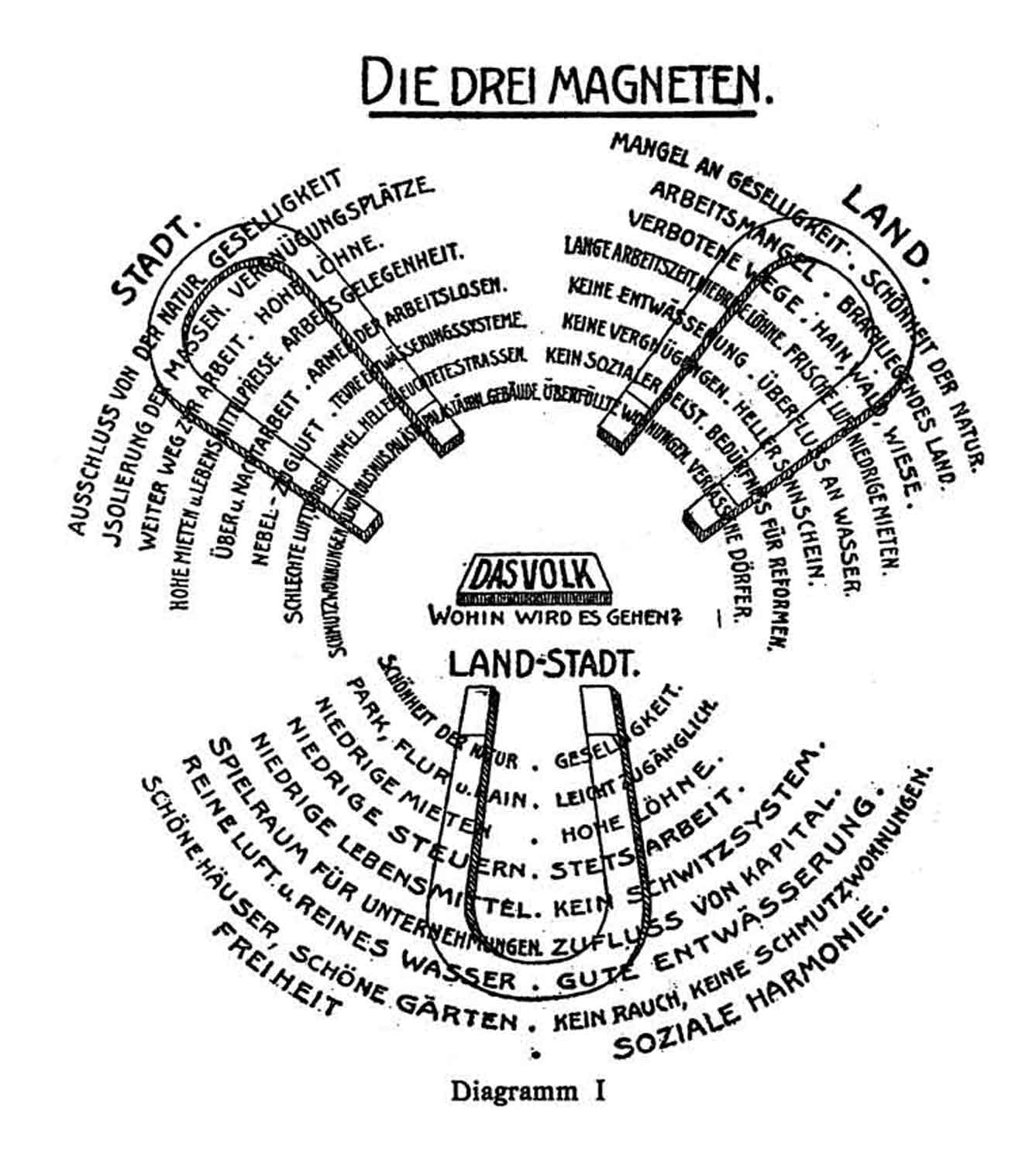Garden City idea⎟ The garden city – model for planning Hellerau
The idea of the garden city came from the Englishman Ebenezer Howard. He wanted to distribute building land fairly through cooperative ownership and create a self-regulating small-scale urban system with the garden city. The founders of Hellerau Garden City also hoped to shape the future residents in a humanistic sense with the help of a new, humane architecture adapted to the natural conditions.
The historical significance of Hellerau Garden City lies in its overarching social and cultural concept, which attempted to implement the intellectual approaches of the Lebensreform (life-reform) movement in the fields of architecture and arts and crafts, education and physical culture, and land reform.
Content of this article

Schematic diagram for the conception of the garden city.
Source: Ebenezer Howard: Gartenstädte in Sicht, Jena, 1907.

Ebenezer Howard's Garden City Model: Core City and Satellites.
Source: Ebenezer Howard: Gartenstädte in Sicht, Jena, 1907
City in the country
The inspiration for the creation of garden cities came from England. In 1898, Ebenezer Howard had published his thoughts on a city in the country as a network of living, working and leisure under the title ‘Garden Cities of Tomorrow’. On the basis of cooperative ownership, self-regulating small urban systems were to emerge, offering an alternative living concept to the rampant Wilhelminian urban sprawl with its poor hygiene, air and light, and lack of greenery.
Social housing
With the founding of the Deutsche Gartenstadtgesellschaft (DGG – German Garden City Society) in 1902, the movement was also given a platform in Germany. It expanded the ideas from England to include the culturally critical thoughts of the philosopher Friedrich Nietzsche, who had called for a radical renewal of bourgeois society. With its social objectives, the garden city movement set itself apart from the factory housing estates, such as those that had been built in Miltitz near Leipzig (around 1900), near Brieske (workers’ colony Grube Marga, 1907) and in Essen (housing estate for the Krupp works on the Margarethenhöhe, from 1905/06). In the case of the factory housing estates, the factory remained the owner of the housing. Anyone who lost their job therefore no longer had a home, and the workers and employees living at low rents were forced to be on their best behaviour in conflict situations. It was precisely this extremely precarious situation that had just led to the desire to do things differently in the garden city.
The founders of Hellerau were not initially members of the Deutsche Gartenstadtgesellschaft (DGG – German Garden City Society), but hoped for organisational and moral support for the implementation of their garden city concept. The DGG, on the other hand, used Hellerau as an exemplary model settlement, even though the garden city always retained its autonomy. The Deutsche Gartenstadtgesellschaft (German Garden City Society) built its first own garden cities in Nuremberg and Karlsruhe in 1911.
Hellerau: humanism through welfare
One important goal of the Hellerau concept was to promote welfare through equitable land distribution. Two societies were founded for this purpose in 1908: the Gartenstadtgesellschaft Hellerau (Hellerau Garden City Society), which was responsible for the allocation of land for country houses and commercial enterprises, and the Baugenossenschaft Hellerau (Hellerau Housing Association), which was to ensure fair land use for small housing construction. The founding fathers kept Hellerau Garden City free of any ideological or nationalist ideas. In fact, they hoped to shape the future residents in a humanistic sense with the help of a new, humane architecture modelled on nature.
The historical significance of Hellerau Garden City lies in its overarching social and cultural concept, which attempted to implement the intellectual approaches of the Lebensreform (life-reform) movement, largely free of the utopian ideals of communal living, in the fields of architecture and arts and crafts, education and physical culture, and land reform.
